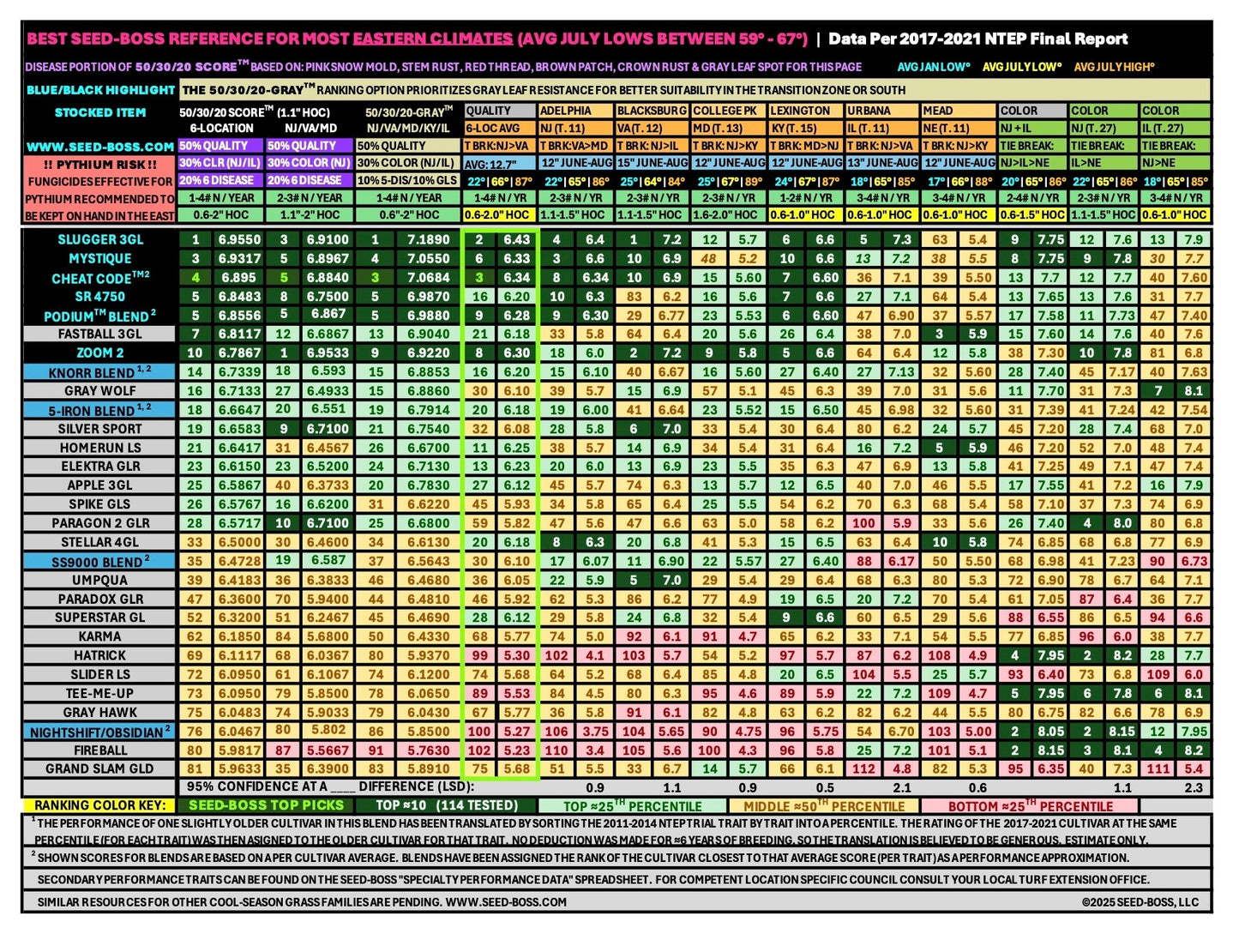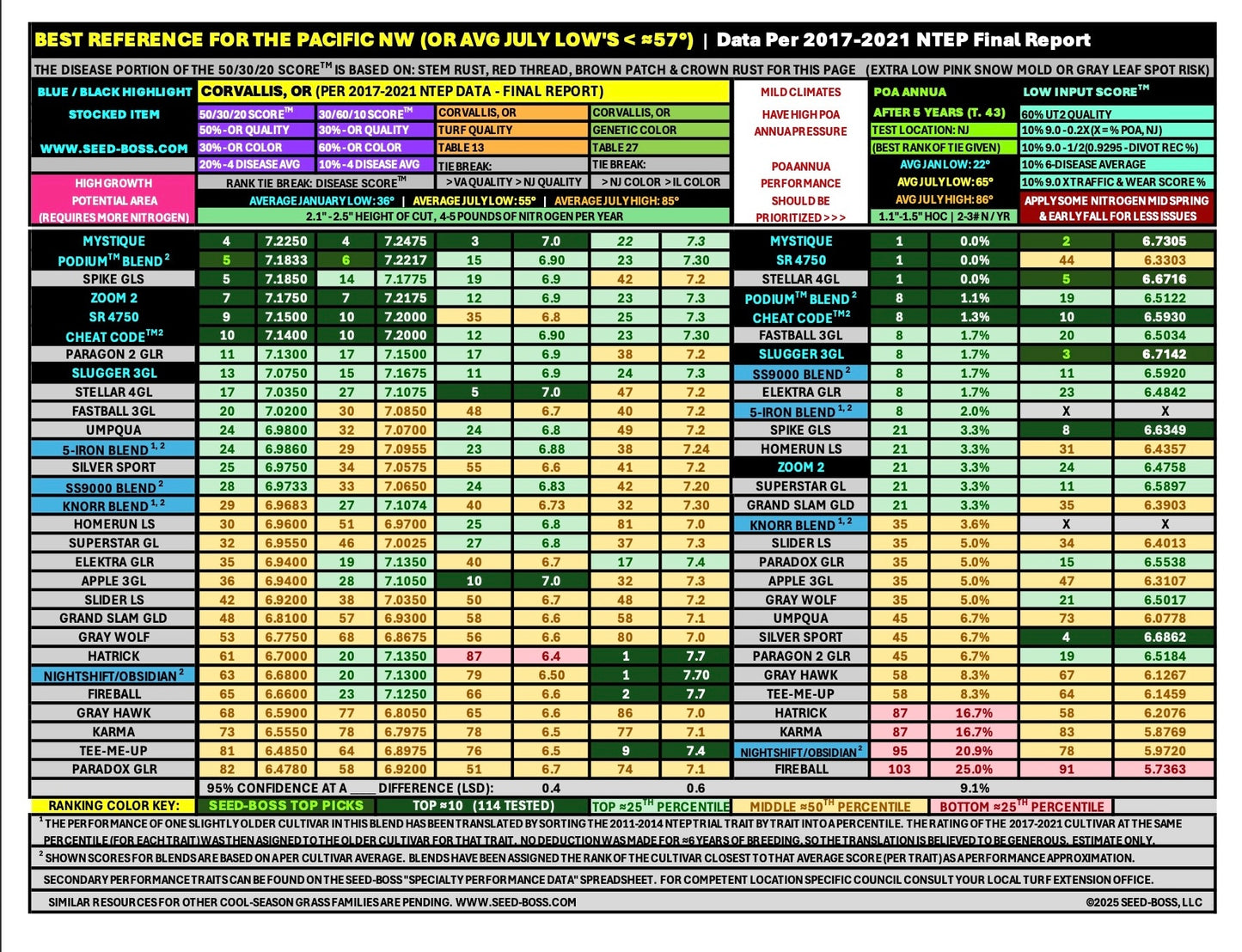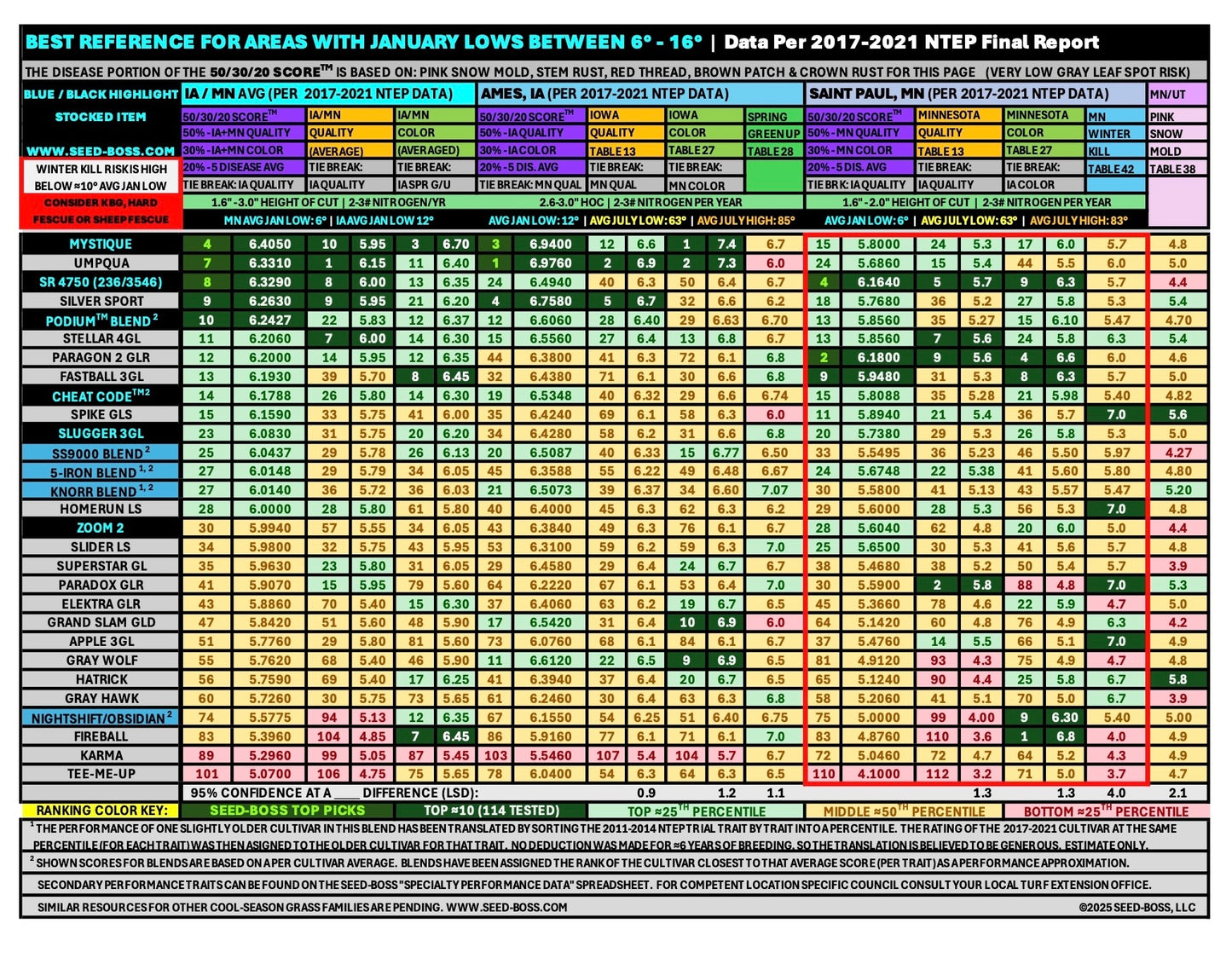Seed-Boss
Excellence™ Perennial Ryegrass Blend - Nearly Identical to PODIUM™ With Superior Drought Performance - But Only 2 Cultivars
Excellence™ Perennial Ryegrass Blend - Nearly Identical to PODIUM™ With Superior Drought Performance - But Only 2 Cultivars
Couldn't load pickup availability
* * All scores are based on data from the 2017-2021 NTEP Perennial Ryegrass Final Report
* * All rankings and scores calculated on a per cultivar average for each blend * *
Pacific Northwest Climate, Corvallis Oregon (Primary Metrics)
50/30/20 Score™ (Corvallis Oregon: 50% Quality, 30% Color, 20% 4-Disease - Crown Rust, Stem Rust, Brown Patch, Red Thread)
EXCELLENCE™: 5th, 7.2000 ( Top 4% )
PODIUM™: 5th, 7.1833 ( Top 4% )
CHEAT CODE™: 10th, 7.1400 ( Top 9% )
5-IRON*: 24th, 6.9860 ( Top 21% )
SS9000: 28th, 6.9733 ( Top 25% )
Knorr Elite Rye*: 29th, 6.9683 ( Top 25% )
Fireball+Hatrick: 63rd, 6.6800 ( Top 55% )
Turf Quality (Corvallis, Oregon)
EXCELLENCE™: 6.95 / 9.0
PODIUM™: 6.9 / 9.0
CHEAT CODE™: 6.9 / 9.0
5-IRON*: 6.88 / 9.0
SS9000: 6.83 / 9.0
Knorr Elite Rye*: 6.73 / 9.0
Fireball+Hatrick: 6.5 / 9.0
Color (Corvallis, Oregon)
Fireball+Hatrick: 7.7 / 9.0
EXCELLENCE™: 7.3 / 9.0
PODIUM™: 7.3 / 9.0
CHEAT CODE™: 7.3 / 9.0
5-IRON*: 7.24 / 9.0
SS9000: 7.2 / 9.0
Knorr Elite Rye*: 7.3 / 9.0
Eastern Fertilized NTEP Locations w/ similar disease pressure - Primary Performance Metrics (NJ+VA+MD+KY+IL+NE, NTEP)
50/30/20 Score™ (Eastern Locations: 50% Quality, 30% Color, 20% 6-Disease - Gray Leaf Spot, Brown Patch, Pink Snow Mold, Red Thread, Crown Rust, Stem Rust)
CHEAT CODE™: 4th, 6.8954 ( Top 4% )
EXCELLENCE™: 5th, 6.8592 ( Top 4% )
PODIUM™: 5th, 6.8556 ( Top 4% )
Knorr Elite Rye*: 14th, 6.7339 ( Top 12% )
5-IRON*: 18th, 6.6647 ( Top 16% )
SS9000: 35th, 6.4728 ( Top 30% )
Fireball+Hatrick: 76th, 6.0467 ( Top 67% )
Turf Quality, Fertilized Locations (NJ+VA+MD+KY+IL+NE)
CHEAT CODE™: 6.34 / 9.0
EXCELLENCE™: 6.32 / 9.0
PODIUM™: 6.28 / 9.0
Knorr Elite Rye*: 6.20 / 9.0
5-IRON*: 6.18 / 9.0
SS9000: 6.10 / 9.0
Fireball+Hatrick: 5.27 / 9.0
Color, Fertilized Locations (IL+NJ)
Fireball+Hatrick: 8.05 / 9.0
CHEAT CODE™: 7.65 / 9.0
PODIUM™: 7.58 / 9.0
EXCELLENCE™: 7.53 / 9.0
Knorr Elite Rye*: 7.4 / 9.0
5-IRON*: 7.39 / 9.0
SS9000: 6.98 / 9.0
Disease Score
PODIUM™: 5th ( Top 4% )
EXCELLENCE™: 8th ( Top 7% )
CHEAT CODE™: 18th ( Top 16% )
Knorr Elite Rye*: 25th ( Top 22% )
5-IRON*: 28th ( Top 25% )
SS9000: 35th ( Top 31% )
Fireball+Hatrick: 96th ( Top 84% )
* Note: regional turf quality & gray leaf spot performance may be more accurate indicators of climate specific disease performance in many cases. This metric is simply an approximation of overall disease performance.
Traffic & Wear Score Rank
EXCELLENCE™: 3rd ( Top 3% )
PODIUM™: 6th ( Top 5% )
CHEAT CODE™: 7th ( Top 6% )
5-IRON*: 14th ( Top 12% )
SS9000: 16th ( Top 14% )
Knorr Elite Rye*: 39th ( Top 34% )
Fireball+Hatrick: 92nd ( Top 81% )
Percent Poa Annua After 5 Years (Context: NJ)
PODIUM™: 1.1%
CHEAT CODE™: 1.3%
EXCELLENCE™: 1.7%
SS9000: 1.7%
5-IRON*: 2.0%
Knorr Elite Rye*: 3.6%
Fireball+Hatrick: 20.9%
Divot Recovery (AKA: Self Repair, Context: KY):
PODIUM™: 3rd ( Top 3% )
* 100% Stoloniferous Varieties
EXCELLENCE™: 4th ( Top 4% )
* 100% Stoloniferous Varieties
CHEAT CODE™: 24th ( Top 21% )
* 60% Stoloniferous ( by seed count )
Knorr Elite Rye*: 33rd ( Top 29% )
5-IRON*: 39th ( Top 34% )
SS9000: 53rd ( Top 46% )
Fireball+Hatrick: 110th ( Top 96% )
Low Input Score (60% Drought / 10% Disease Score / 10% Poa Annua Invasion / 10% Traffic & Wear Score )
EXCELLENCE™: 9th ( Top 8% )
CHEAT CODE™: 10th ( Top 9% )
SS9000: 11th ( Top 10% )
PODIUM™: 19th ( Top 17% )
Fireball+Hatrick: 78th ( Top 68% )
Seedheads (Context: MA):
Knorr Elite Rye*: 6.4 / 9.0
5-IRON*: 6.16 / 9.0
CHEAT CODE™: 5.8 / 9.0
Fireball+Hatrick: 5.7 / 9.0
PODIUM™: 5.67 / 9.0
SS9000: 5.53 / 9.0
EXCELLENCE™: 5.5 / 9.0
NOMINAL COMPOSITION OF SEED-BOSS BLENDS
EXCELLENCE™ Blend: 50% Mystique / 50% Zoom 2
PODIUM™ Blend: 34% Mystique, 33% Zoom 2, 33% SR4750
CHEAT CODE™ Blend: 40% Slugger 3GL, 20% Mystique, 20% Zoom 2, 20% SR4750
Common overseeding seed rate: 3-5 pounds per 1,000' (175-220 lbs / acre)
Common bare dirt seed rate: 7-9 pounds per 1,000' (300-400 lbs / acre)… closer to 9# low cut… closer to 7.5# high cut.
Caution: More seed is not necessarily better than less seed. Lower seed rates may improve color and reduce disease pressure. For bare spots, very light spot seeding is recommended rather than overseeding when possible to reduce crowding in already dense areas.
TIPS FOR SUCCESS
-
Seed germination basics:
- Bare dirt is ideal (or at least no thatch)
- Adhere to proper seed rate... too little seed means increased weed pressure and increased erosion risk, and too much seed can mean lesser color and increased risk of disease.
- Rake seed in w/ a Groundskeeper II rake (or slit seed if you can on a low setting)... grass seed sitting on the surface will be unlikely to germinate
- Keep soil moist and never dry or soaked until germination... perennial ryegrass doesn't need as much water during germination to germinate... I physically touch the dirt prior to watering most of the time... often soil is already moist and more hours can pass before water is needed. Watering just once per day is typically enough for perennial ryegrass to germinate well as long as some water is getting into the soil profile (at least 60% of reference evapotranspiration). A bookmarkable evapotranspiration map specific to your city can be requested free of charge by email.
- Water for enough days to germinate your slowest germinating seed. Grasses within a given grass family tend to have similar germination timing. Fall seeding tends to germinate considerably faster than a spring seeding.
- A germination rate of 50% starts around 50° soil temps for most cultivars... seeding before soil is warm enough may reduce germination. I like to aim for 50-55° soil temps for spring seeding (slow germination but better summer hardiness) or let soil dip to about 65° for fall seeding (or when regular light rain is expected). It's important not to seed too late for fall seedings especially on bare dirt because if soil cools too much grass seed won't germinate at all. Germination at least 45 days before average first frost is a common rule of thumb to allow enough winter hardiness, but this rule of thumb can generally be ignored in areas with mild Winters like the PNW or the United Kingdom.
- For spring seeding, regular early nitrogen is extra important to maximize establishment prior to summer conditions. 1/2# of N per 1,000 square feet at seeding as well as 1/2# of N about every 4 weeks for at least a few months can get the grass off to a good start (Note: 1.09# of urea dissolved in water / 1,000' = 1/2# of N). The larger the droplets the better... I like a TeeJet TTI11004 spray tip for applying fertilizer. Fertilizer should be immediately rinsed off of the grass blades after application to avoid tip burn or 2 gallons of water per pound of urea can be left unrinsed.
- After germination has concluded, the grass only needs to be watered to the point of survival... 1 fairly light watering every few days is likely enough water during the first few weeks. If you see the grass start to wilt more water is needed... if it is raining, it's best not to water are all. Touch the dirt.
- Once the grass is a few weeks old, not enough water is usually better than too much, since disease loves excess water! We recommend owning a soil probe; If you aren't sure if you should water, simply pull a soil core or two... cores can be quite dry before water is actually needed. For perennial ryegrass (and grass in general) the best turf quality in research is most commonly seen with a watering interval of 2-3 days between waterings. Watering at 70% reference evapotranspiration should be close for taller rye in full sun and watering at 75-80% reference ET should be close for low-cut rye (deduct rainfall). Time of day matters with water... watering should be concluded around the time that sunlight first hits an area (often some time before 8:00AM). Evening & night watering maximizes disease pressure and watering during daylight hours can be much less efficient due to excessive evaporation prior to percolation.
- With rare exception, I recommend avoiding potassium, micronutrients, and phosphorus like the plague and just apply nitrogen to get the best possible turf quality with the least amount of problems and work but cold areas may benefit from applied potassium to reduce winter kill if potassium is low enough (rye should have soil K around 120-140PPM Mehlich-3 in areas with high winter kill risk like Minnesota). Foliar iron is ok, but I personally don't use it. Before you assume a soil applied product is going to improve your soil, we recommend taking a cold shower, slap yourself in the face (if necessary), and then binge Turfgrass Epistimology study reviews on YouTube (the live tab is best) until the urge to purchase a given product subsides.
- Full renovations are recommended rather than overseeding when a major upgrade is desired. Overseeding yields comparatively poor germination rates and the original (generally less desirable) grasses will largely survive and water down your results.
-
Observe the 1/3 rule with sharp blades. An All American Sharpener style grinding jig is great if rotary mowing, and a flat file can be used to push the burr off for that last bit of sharpness. The 1/3 rule is per day or two... not per pass. If you can't mow frequently enough to observe the 1/3 rule, bringing the height of cut up allows more time between mows. 1/3 of 4" allows more growing time than 1/3 of 2".
-
If the ground is mushy to the touch, try to wait for a dryer day to mow if possible. Most compaction happens when ground is too wet. The easiest way to cure compaction is often to prevent it, but of course, sometimes compromises have to be made to keep grass height under control.
-
Where there's lots of shade, mow higher or consider TTTF or fine fescue. Lower nitrogen rates in shade can slow growth to improve shade survival and low soil moisture or excessive tree debris are also common disadvantages that may be assumed to be light deficiency.
-
Where there's traffic, more nitrogen is needed.
-
Nitrogen rate should mirror growth potential. If it's growing slowly due to heat or cold, lower rates should be applied or none at all. Avoid medium or heavy nitrogen applications in summer to reduce disease. In the most mild of areas sometimes the highest growth potential (and the most N) happens during summer. If you see dollar spot, red thread, or rust, those will generally improve when nitrogen is added as long as temperature or light isn't the limiting nutrient. Heat loving diseases that prefer high nitrogen include brown patch, pythium, and leaf spot. Try to take nitrogen timing and rate seriously to reduce disease pressure - see PaceTurf.org growth potential model.
- Approximately 1.0% annual ryegrass is common in perennial rye when black light root testing is how the “other crop” was determined but when the same seed is genetically tested usually the majority of the other crop ends up actually being perennial ryegrass because a portion of PRG roots fluoresce under a black light. For good measure we still recommend not going too long between mowing during seedhead stage for the first year to halt the life cycle of any possible annual ryegrass, so no field conditions year one.
- Perennial rye has unusually nasty woody seed head stocks that can leave a yellow hue to your lawn for months and months if not addressed. An annual "seedhead reset" can greatly reduce the effects of this undesirable trait of ryegrass (see below). A seedhead reset is moderately stressful to the lawn and ideally should not be attempted under times of high disease pressure or other major stresses. In areas with higher disease pressure (east especially) a less intense scalping height would probably be prudent.
How to do a seed head reset:
- Once the seedhead stage starts each year, mow at the usual mowing height for about a month
- Then, mow often (with very sharp blades) and gradually reduce the mowing height over the next few weeks down to approximately half the preferred cutting height.
- About 1 week before the lowest mow, apply approximately .5# of nitrogen and make sure the lawn is receiving around 1" of water per week via rainfall and irrigation (early AM water is efficient and may minimizes disease pressure... around 1/2" of water every 3-4 days is an approximation for most areas during drought.)
- Return to your original cutting height. The seed head stocks should be hidden below soft new blades of grass and the straw colored seedhead stocks should be hidden from view.
Disclaimer: For any details relevant to decision making related to grass seed, we recommend referencing NTEP directly when possible. This resource is intended as a user friendly supplement to NTEP data (NOT A REPLACEMENT). Comparative gaps beyond LSD (least statistical difference) on NTEP offer a 95% confidence level. When LSD is not available, no specific confidence level is possible or implied... these are simply the raw numbers. In general the higher the gap, the higher the confidence and small gaps should be considered as equals in most cases but technically the higher number is still more likely to be better even when the gap is under the LSD. This website is constantly being improved for accuracy to the best of my ability... if you notice an error or inconsistency or don't understand where certain came from, please don't hesitate to bring it to my attention via email or text. This website almost certainly does contain unintentional typos or errors and possibly out of date information (for example: when brands change the cultivars in their blends).
Seed-Boss makes no guarantee of performance in your climate or under your management practices. Minimizing stress on the grass tends to create the healthiest and best looking grass - which means food (occasional nitrogen), an occasional 1/2" water during drought, sun light, sharp blades, observing the 1/3 rule, etc. All grass seed sold has been tested for germination of at least 85%, and typically at least 90%... if the grass seed does not germinate the buyer acknowledges improper seed to soil contact, improper soil moisture during germination phase, and/or inappropriate soil temperatures and agrees to not blame seed (that was tested as good).
Competitor blend performance averages based on the following cultivars:
5-Iron: Apple 3GL, Fastball 3GL, Slugger 3GL, Stellar 4GL, Infusion* (JR-178 testing name)
SS9000: Grand Slam GLD, Stellar 4GL, Slugger 3GL
Knorr Elite Rye: Electra GLR, Paradox GLR, Pangea*
NIGHTSHIFT/Obsidian: Fireball, Hatrick
* The performance of one older cultivar in this blend has been translated by sorting the 2011-2014 NTEP trial data into a percentile among all cultivars in that trial on a trait by trait basis. The rating of the cultivar at the same percentile per the 2017-2021 data was then assigned to the older cultivar trait by trait. No deduction was made for 7 years of breeding with the Infusion (AKA: JR-178) cultivar for the 5-Iron blend or the Pangea cultivar in Ryan Knorr's Elite Rye. These numbers are intended to estimate performance as accurately as possible but it should be considered an estimate only.
** Slightly older infusion cultivar exempt from averaging for 5-Iron and the slightly older Pangea cultivar exempt from averaging for Knorr for the Low Input Score trait due to difficulty of translation.
If you notice anything inaccurate or that could be improved for accuracy, please email us at SUPPORT@SEED-BOSS.COM. Our aim is the highest degree of accuracy possible and that process includes peer review.














